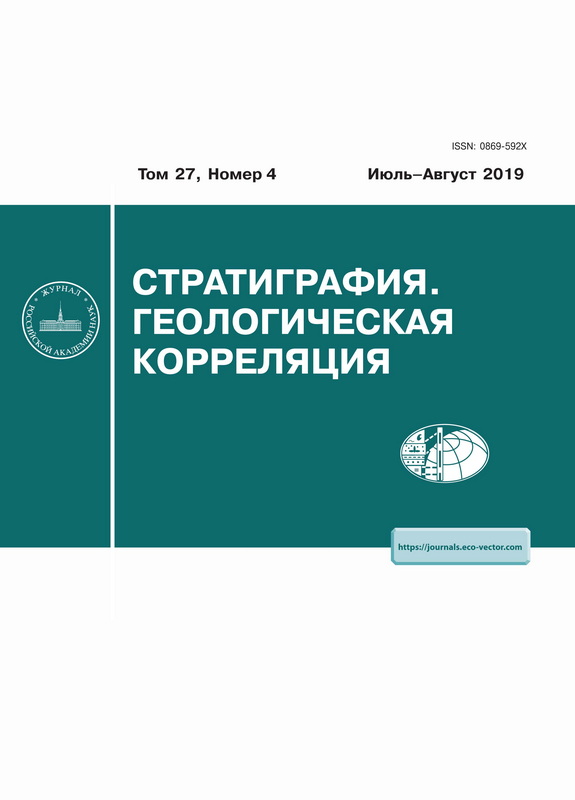Том 27, № 4 (2019)
- Год: 2019
- Статей: 5
- URL: https://journals.eco-vector.com/0869-592X/issue/view/808
- DOI: https://doi.org/10.31857/S0869-592X274
Статьи
Позднеладинско-раннекарнийские радиолярии в разрезе ручья Правый Водопадный, Омолонский массив, Северо-Восток России
Аннотация
Впервые обнаружен и изучен комплекс позднеладинско-раннекарнийских радиолярий из разреза ручья Правый Водопадный Омолонского массива (Северо-Восток России). В составе комплекса установлены раннекарнийские виды радиолярий, описанные ранее из разрезов острова Котельный (Новосибирские острова): Glomeropyle aculeatum, G. cuneum и Pseudoeucyrtis annosus, а также виды, известные из позднего ладина разреза Джугаджак (Омолонский массив): Glomeropyle algidum и Pseudostylosphaera omolonica. Таксономический состав комплекса (преобладание представителей рода Glomeropyle) указывает на его высокоширотное (бореальное) происхождение. Общность состава одновозрастных комплексов радиолярий верхнего ладина–нижнего карния Омолонского массива и Новосибирских островов дает основание говорить о перспективности использования радиолярий для корреляции бореальных разрезов триаса.
 3-12
3-12


Морские рептилии и климат юры и мела Сибири
Аннотация
Обобщены все имеющиеся к настоящему времени данные по климатам юры и мела Сибири, основанные на изотопных, палеонтологических и литологических индикаторах. Четко фиксируются позднеплинсбахское похолодание, раннетоарское потепление, уже в конце тоара сменившееся долговременным среднеюрским похолоданием, и долговременный теплый интервал в поздней юре. С конца рязанского века началось постепенное похолодание, которое, по всей видимости, продолжалось в течение всей раннемеловой эпохи за исключением кратковременного раннеаптского потепления. В начале позднего мела климат стал более теплым, пик потепления фиксируется на рубеже сеномана и турона. Затем в среднем–позднем туроне наступило относительное похолодание. Позднее, в коньяке–кампане, климат вновь потеплел, но в конце кампана наступило очередное похолодание. Описаны новые находки морских рептилий из тоарских, кимериджских, волжских и сантон-кампанских отложений севера Восточной Сибири. Ревизованы все имеющиеся данные по находкам морских позвоночных, известных из юры и мела Сибири, при этом все находки (из 51 местонахождения) привязаны к палеоширотам. Установлено, что большинство местонахождений остатков этих животных находились в заполярных палеоширотах (70°–87°). При этом прямой связи между колебаниями климата и распространением этих организмов обнаружить не удалось. С учетом новейших данных, свидетельствующих, что представители большинства групп крупных морских рептилий юры и мела были способны поддерживать более-менее постоянную температуру тела, а также могли предпринимать масштабные сезонные миграции, стоит с осторожностью относиться к привлечению остатков этих животных в качестве индикаторов теплого климата.
 13-39
13-39


Стратиграфия нижнего и среднего Турона (верхний мел) Приенисейской (левобережной) части Западной Сибири по иноцерамидам и фораминиферам
Аннотация
Представлены результаты лито-биостратиграфического изучения нижней части морского разреза верхнего мела на территории Большехетской структурной террасы на левобережье р. Енисей в ее нижнем течении (верхи долганской свиты, дорожковская свита и низы насоновской свиты; туронский ярус). Выделено 11 литологических пачек, устойчиво прослеживающихся на территории исследований. Каждая пачка получила палеонтологическую характеристику. Выделены слои с фауной (иноцерамидами и фораминиферами) и сопоставлены с зональными подразделениями турона Западной Сибири. Установлено, что верхняя часть долганской свиты относится к нижнему подъярусу турона, зоне Mytiloides labiatus. Дорожковская свита в изученном районе, близком к ее стратотипической местности, соответствует нижнему и среднему турону.
 40-58
40-58


Опорный разрез олигоцена Юга Восточно-Европейской платформы (Северные Ергени)
Аннотация
Комплексно изучен разрез олигоценовых (майкопских) и подстилающих эоценовых отложений скважины 768 глубиной 362 м, который может служить опорным как для Северных Ергеней, так и для всей северной части Восточного Паратетиса. Данные по литологии, моллюскам и бентосным фораминиферам дали возможность расчленить олигоценовую часть майкопской серии на свиты и подсвиты: цимлянскую, соленовскую и калмыцкую, сопоставить их с соседними и удаленными частями Паратетиса, с региоярусной шкалой, восстановить основные условия осадконакопления. По наннопланктону и диноцистам эти подразделения сопоставлены с зональной международной шкалой (Gradstein et al., 2012), а по спорово-пыльцевым данным восстановлена эволюция климата северной окраины Паратетиса. Фитопланктонные, фораминиферовые и палеомагнитные данные показывают сильную редукцию разреза в эоценовой части, где выделены только отрицательно намагниченные фрагменты керестинской, кумской и белоглинской свит, разделенные поверхностями несогласий, и полный набор биотических и палеомагнитных зон нижнего олигоцена. Редкой полнотой отличается нижняя подсвита соленовской свиты (50 м), размытая в большинстве разрезов Предкавказья. Калмыцкая свита в этом разрезе, вероятно, неполная и отвечает лишь первой половине хатта.
 59-92
59-92


Изменения ландшафтно-климатической обстановки Восточной Европы в раннем плейстоцене
Аннотация
В связи с понижением границы квартера до уровня 2.6 млн лет назад и включением в него гелазийского яруса проведена систематизация оригинальных и литературных данных по геологии и палеогеографии позднего плиоцена и раннего плейстоцена Восточной Европы. Установлено, что на рубеже палеомагнитных эпох Гаусс/Матуяма на фоне общего тренда к похолоданию и аридизации произошли глубокие изменения ландшафтно-климатической обстановки и усилились ритмические колебания климата. В период от 2.6 до 1.8 млн лет, соответствующий гелазию (претегелену и тегелену Западной Европы или палеоплейстоцену Восточной Европы), появились субарктические ландшафты. В эоплейстоцене (1.8–0.78 млн лет) и раннем неоплейстоцене (0.78–0.42 млн лет) климат становился холоднее, а структура природной зональности неоднократно претерпевала сложную перестройку, постепенно приближаясь к современной. Присутствие ледниковых отложений в виде морен отмечено на территории Восточной Европы уже в палеоплейстоцене. В эоплейстоцене (1.8–0.78 млн лет) проявляются следы не менее трех самостоятельных оледенений, а в раннем неоплейстоцене, возможно, четырех. По материалам изучения стратотипических разрезов устанавливаются парагенетические связи между разновозрастными отложениями ледниковых и перигляциальных областей, проводится корреляция палеогеографических событий раннего плейстоцена Восточной Европы с Западно-Европейским регионом.
 93-116
93-116










